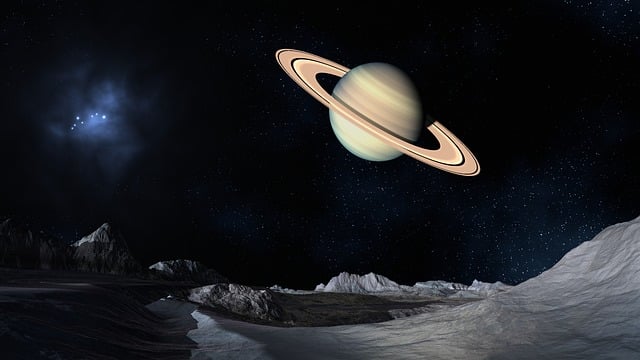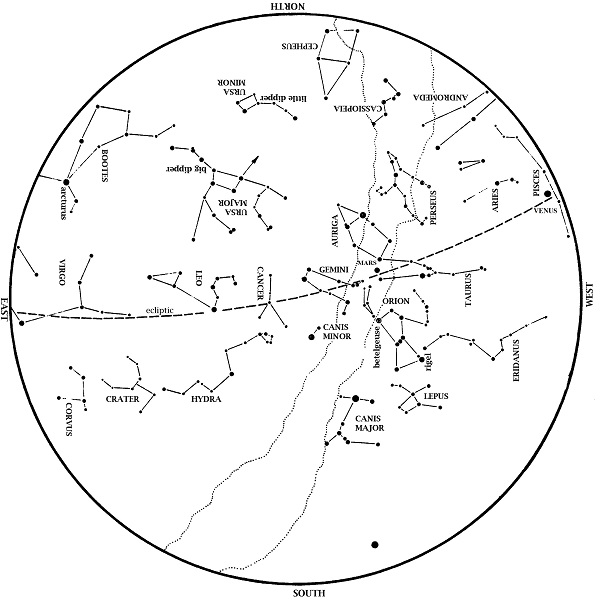The Moon This Month

1st Quarter: February 2, 10:19am Full: February 10, 6:33pm
3rd Quarter: February 18, 1:35am New: February 26, 9:00am
The Full Moon of February 10 almost enters the Earth’s shadow. Rather, it enters the penumbra, a region of space where the Earth only partially blocks the Sun, and is in the penumbra at moonrise for us. The resulting penumbral eclipse is barely noticeable. However, a careful observer may notice the Moon is slightly dimmer at moonrise on February 10 than later on that night.
Chart of the penumbral eclipse of 2006. photo courtesy of Wikipedia.
Your Guide to the Stars during February, 2017
This star map shows the Houston sky at 9 pm CST on February 1, 8 pm CST on February 14, and dusk on February 28. To use the map, put the direction you are facing at the bottom.
Taurus, the Bull, is almost overhead along with Gemini, the Twins. Dazzling Orion, the Hunter is high in the south, with his two dogs behind him. Sirius, the Big Dog Star, is the brightest star we ever see at night. Look for Canopus on the southern horizon below Sirius. Jupiter, in Leo, is up almost all night long by late February. In the north, the Big Dipper has re-entered the evening sky.
What To Look For In The Sky This Month:
A view of London in 1748, with diagrams of an ecl. Photo courtesy of Wikimedia commons
Venus begins to head back towards the Sun this month, although it remains easily visible. (In fact, it is coming around to our side of the Sun, about to overtake the Earth.) Look in the west in evening twilight. Venus noticeably moves away from the much dimmer Mars during February.
Mars is now in the west at dusk. Mars continues to fade each night as Earth leaves it farther and farther behind.
Jupiter remains in the morning sky this month. Look in the south-southwest at dawn.
Saturn is low in the southeast at dawn this month, more towards the south by month’s end.
Taurus, the Bull is high in the south. Look for the Pleiades star cluster above reddish Aldebaran. Dazzling Orion, the Hunter takes center stage on winter evenings. Surrounding Orion are the brilliant stars of winter. Orion’s belt points down to Sirius, the Dog Star, which outshines all other stars we ever see at night. The Little Dog Star, Procyon, rises with Sirius and is level with Orion’s shoulder as they swing towards the south. To the upper left of Orion’s shoulder is Gemini, the Twins.
Under Sirius and low to the southern horizon this month is a star that most Americans never get to see—Canopus. Representing the bottom (keel) of the legendary ship Argo, Canopus is the second brightest star ever visible at night. Thus, it is clearly noticeable along the southern horizon on February and March evenings. However, you must be south of 37 degrees north to see Canopus rise. (This is the line that divides Utah, Colorado, and Kansas from Arizona, New Mexico, and Oklahoma.)
The sky we see depends on our latitude as well as on the time of night and time of year. From any given location in our hemisphere, stars in an area of the sky around the North Star never set (circumpolar stars), while stars in an equivalent area around the South Celestial Pole never rise. The closer you are to the pole, the larger these areas are. The closer you get to the equator, the fewer circumpolar stars there are, but there are also fewer stars that never rise for you. At the equator, no stars are either circumpolar or never visible; all of them rise and set as Earth turns.
That’s why, down here in south Texas, the Big Dipper sets for a while although it’s always up for most Americans. On the other hand, Canopus, too far south to rise for most Americans, rises for us.
Would you like email updates on current events in the sky, at the planetarium, and at George Observatory? If so, send an email to astroinfo@hmns.org.
And don’t forget to come see us Saturday nights at the George Observatory! On most clear Saturday nights at the George Observatory, you can hear me do live star tours on the observation deck with a green laser pointer.









